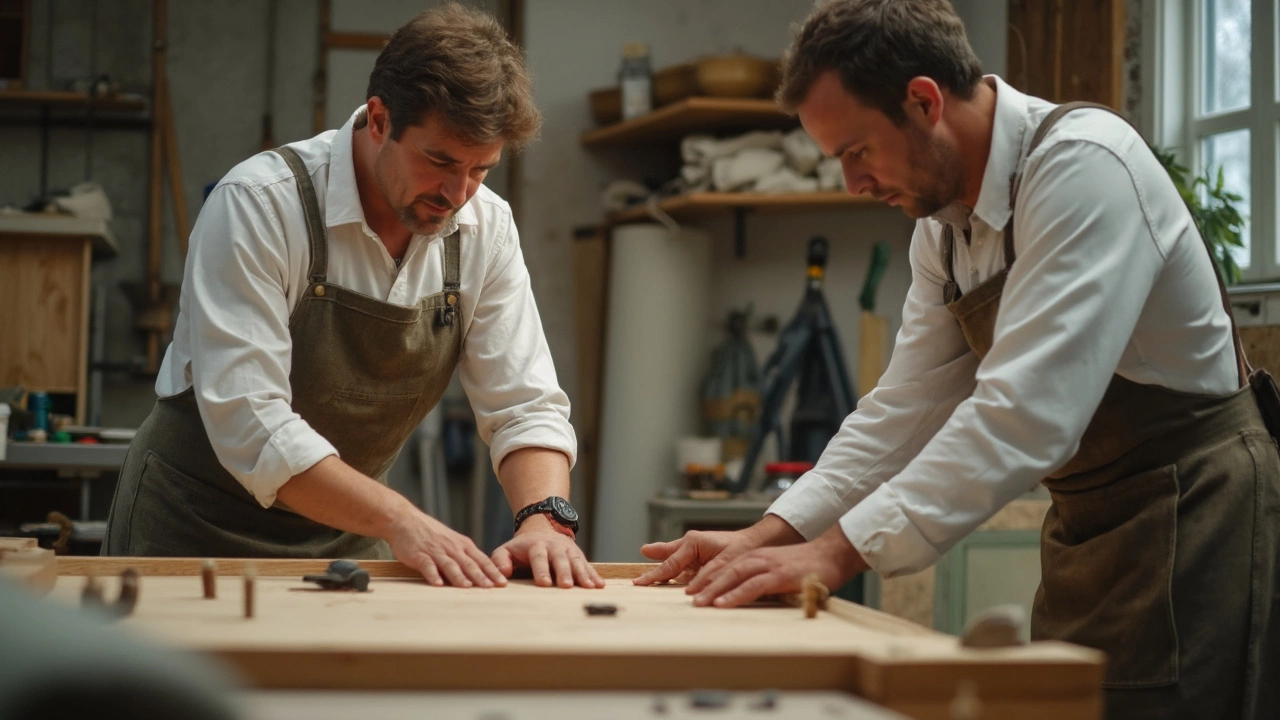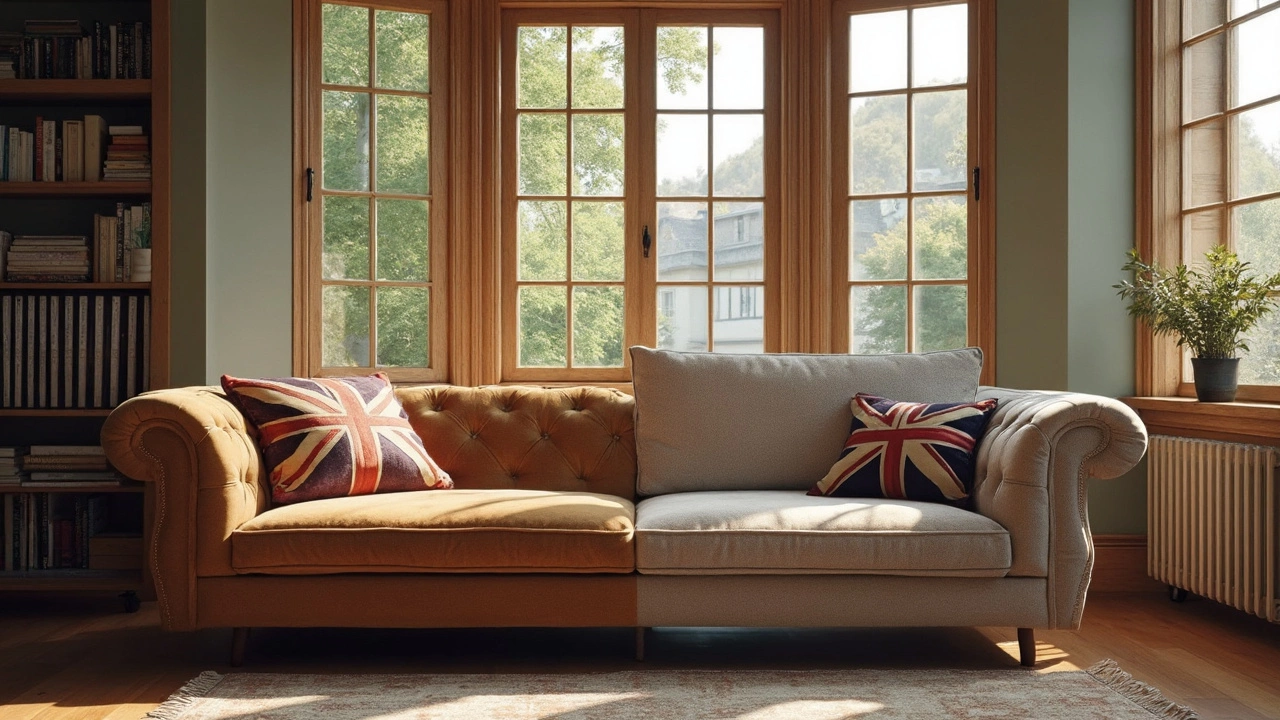Standing in a furniture store, it’s easy to wonder if that fancy, expensive couch is secretly a superhero packed in velvet—or if it's just a price tag flex. Here’s the deal: the jump in cost isn’t always about extra years tacked onto its life. Sometimes you’re buying top-quality materials, but sometimes… it’s all about the brand.
A lot of folks think higher price equals longer lifespan. Not always. What really matters are things like the frame, the type of foam, and even the stitching. If a $500 couch uses a particle board frame and a $3,000 sofa uses kiln-dried hardwood, you better believe that matters way more than the logo on the cushion. Cheaper couches often sag out or break just a few years in, while better-built ones can last over a decade if you treat them right.
If comfort is king, then construction is the castle. It’s worth poking under those cushions and asking, "What's this frame made of? How are the cushions filled?" because those answers will tell you more than the snazzy showroom lighting ever will. And hey—sometimes it’s just a rip-off, so don’t be shy about digging for the real details before you pull out your wallet.
- Price vs. Lifespan: The Real Connection
- What Makes a Couch Last?
- Branding, Trends, and the Hidden Costs
- How to Check Quality Before You Buy
- Keeping Your Couch Alive: Maintenance Tips
Price vs. Lifespan: The Real Connection
Let’s be honest, most people expect an expensive couch to last years—maybe even decades. Thing is, price tags can be sneaky. The real difference in how long a couch holds up almost always comes down to what’s inside and underneath, not just the sticker shock or color trend.
Here’s a clear look at what you’re actually paying for when you see a higher price:
- Materials: Cheaper sofas use particle board or plastic frames, while high-end ones use kiln-dried hardwood. Guess which one handles bouncy kids and movie nights better? Yep, it’s the wood.
- Cushion Quality: Lower-cost couches often cut corners with cheap foam that flattens out in no time. Higher-priced sofas use high-resilience foam or even down, which holds its shape year after year.
- Construction: More expensive couches usually have reinforced joints (like double-dowel or corner blocks) instead of staples and glue. This helps prevent those annoying wobbly arms.
But don’t just take the retailer’s word. According to a 2023 survey by the Home Furnishings Association, the average lifespan for a budget couch is about 5-7 years, while pricier, well-built sofas last 12-15 years or even longer.
| Sofa Price Range | Expected Lifespan |
|---|---|
| Under $800 | 5-7 years |
| $1,000 to $3,000 | 8-15 years |
| Above $3,000 | 12-20+ years |
So, is the jump in price always justified? Not if you’re just paying for a designer label or super-trendy fabric. But if what’s inside matches the price—like solid frames and quality foam—the sofa set should definitely stick around longer.
Bottom line: Don’t get dazzled by price alone. A good test? Ask about what’s under the fabric, poke around, and look for real answers on those materials and construction details.
What Makes a Couch Last?
If you want a durable couch, forget the fancy throw pillows and look under the hood. The guts of the thing—its frame, suspension, filling, and fabric—make all the difference. Here’s what actually matters when it comes to keeping your sofa set in the game for years.
- Frame Material: The frame is the backbone. Kiln-dried hardwood, like oak or maple, holds up way longer than soft woods or particle board. Metal frames can also be solid, but they’re less common (and can be heavy).
- Joints and Construction: Frames joined with dowels, brackets, or corner blocks last much longer than those held together with plain old staples or glue. Solid joinery is key.
- Suspension System: Webbing and springs keep you from sinking into the abyss. Eight-way hand-tied springs are the gold standard—more so in expensive couches.
- Cushion Fill: High-density foam or foam wrapped with down lasts longer and keeps its shape. Low-density foam flattens out fast, which is a pain in the back and the wallet.
- Upholstery: Durable fabrics like leather, microfiber, or tightly woven synthetics are more forgiving of spills and rough use. Thin cotton looks nice but wears out with daily sitting or bouncing (kids, we’re looking at you).
Still not convinced? The guys at Consumer Reports once said,
“A well-built sofa should give you at least 10 years of comfort, and the best can go beyond 15.”
If you’re someone who loves data, here’s a quick side-by-side:
| Feature | Cheap Couches | Expensive Couches |
|---|---|---|
| Frame | Particle board, softwood | Kiln-dried hardwood |
| Joints | Glue, staples | Dowels, brackets, corner blocks |
| Springs | None or basic webbing | Eight-way hand-tied, quality webbing |
| Cushion | Low-density foam | High-density foam, down-wrapped |
| Fabric | Thin, basic fabric | Leather, microfiber, strong synthetics |
So next time you’re couch-shopping, dig a little deeper than the color swatches. Ask about the frame, open up the cushions, and poke around the seams. It’s way less glamorous than browsing throw pillows, but that’s where the real value hides.

Branding, Trends, and the Hidden Costs
Let’s talk about the silent drivers behind that jaw-dropping price tag on expensive couches. Sometimes the cost is pumped up by the brand’s reputation, not the actual build. You might be shocked to know that big designer names can mark up their pieces two to three times more than lesser-known brands with the same materials. Why? Because the logo stitched on the tag is worth that much to some people.
Trends add another layer. Every year, certain fabrics, colors, or shapes hit the spotlight—think of velvet sofas or curved silhouettes that fill up your Instagram feed. Retailers know this and cash in big. You’re often paying extra just because it’s the “look of the year,” not because that green velvet will survive your kids’ snack attacks.
Then, there are the hidden costs: delivery fees, warranty plans, or even having to buy matching pillows that aren’t included in the quote. Toss in maintenance expenses for special fabrics or custom stain treatments, and things climb fast.
"You’re often not just paying for quality materials or durability—you’re paying for a sense of exclusivity," says Michael Faw, a senior buyer at a major furniture chain. "There’s a marketing cost built right into premium-priced sofa sets."
There’s real data to this. A 2023 industry report found that nearly 60% of price increases for luxury furniture were tied to brand prestige and trend marketing, not materials or craftsmanship.
| Cost Factor | Typical Impact on Price |
|---|---|
| Brand Name | +30% to +60% |
| Trend Markups | +10% to +25% |
| Build Quality | +20% to +40% |
| Hidden Fees | Varies (delivery, extras) |
Here’s a quick hack: when you’re shopping for sofa sets, always break down the price with the salesperson. Ask what portion goes to materials, what’s for shipping, and if you can skip branded add-ons and extra flair you don’t need. Don’t assume high price means longer lifespan—most of the cost might just be that little metal badge on the arm.
How to Check Quality Before You Buy
Here’s the reality: the look of a sofa set doesn’t tell you much about its real staying power. If you want a durable couch you won’t regret, you’ve got to dig deeper. Here’s how you spot the difference between a fancy fake and a real-deal, long-lasting buy.
- Frame Material: Always ask what the couch frame is made of. Quality furniture uses kiln-dried hardwood like oak, ash, or maple. Cheap ones usually use pine, particle board, or plastic—these just don’t cut it for the long haul.
- Joinery: Look under the sofa if you can. The best frames use dowels, screws, or corner blocks. If you see staples or glue holding it together, that’s a red flag.
- Cushion Filling: High-resilience foam wrapped in down or Dacron holds shape and stays comfy for years. Pure down is comfy but needs fluffing and loses shape. Cheap couches? You’ll find low-density foam that breaks down fast.
- Upholstery: Tight, even stitching means quality. Fabrics like full-grain leather or heavy-duty synthetics survive spills and pets better than cheap cotton or bonded leather (which flakes over time).
- Spring System: If you can, ask to lift the cushions and check for eight-way hand-tied springs—that’s the gold standard. Sinuous (S-shaped) springs are common and pretty good, but avoid webbing only, which sags easily.
Sometimes you’ll see a “Martindale rub test” score listed for upholstery fabric—anything above 20,000 rubs is considered durable for home use.
| Component | What to Look For | Avoid These |
|---|---|---|
| Frame | Solid hardwood | Pine, particle board |
| Joinery | Dovetail, screwed, dowelled | Stapled, glued |
| Cushion | High-resilience foam, wrapped | Low-density foam, fiberfill |
| Upholstery | Full-grain leather, heavy synthetics | Bonded leather, thin fabric |
Don’t forget to lift one corner of the couch—if it wobbles and the other front leg doesn’t leave the ground, skip it. A solid sofa set will not twist or flex easily. If you buy online, check for close-up photos, fabric rub ratings, and reviews mentioning frame weight or durability.

Keeping Your Couch Alive: Maintenance Tips
Even the fanciest expensive couches can fall apart early if you skip the basics. Regular care is what keeps a sofa set looking new, no matter the price tag. And honestly, it doesn’t take much time—just a little routine and know-how.
Here’s what actually helps your couch last:
- Vacuum Weekly: Dust, pet hair, and crumbs get into the fabric and seams. Regular vacuuming stops the grit that wears down the material.
- Flip and Rotate Cushions: Especially on pricier couches, cushions can get lopsided pretty fast. Give them a flip and swap spots once a month to keep them shapely and comfy.
- Treat Spills Fast: Blot, don’t rub. Use a clean cloth and check the manufacturer’s cleaning code. Most stains set fast, so don’t wait.
- Keep Out of Direct Sun: Even the best fabrics and leathers fade or crack if you park them in a sunbeam. If you can't rearrange, throw a cover on for daytime.
- Watch the Weight Limits: Believe it or not, even a designer sofa set needs to follow the max weight rules, which you can usually find in the manuals or tags.
- Tighten Bolts and Screws: Every six months, check the legs and frames. Wiggle anything loose back into place to avoid a wobbly future.
Ever wondered how much cleaning helps with durability? Check this out:
| Cleaning Frequency | Average Sofa Lifespan (Years) |
|---|---|
| Weekly | 12 |
| Monthly | 8 |
| Rarely | 5 |
One last pro tip: If you invest in an expensive couch, find out about the warranty or professional cleaning deals. Some brands throw in a free yearly clean, which really adds value and stretches that sofa set lifespan. Routine care and the right cleaning methods go way further than most folks expect—treat your sofa well, and it’ll stick around a lot longer than the trends.



